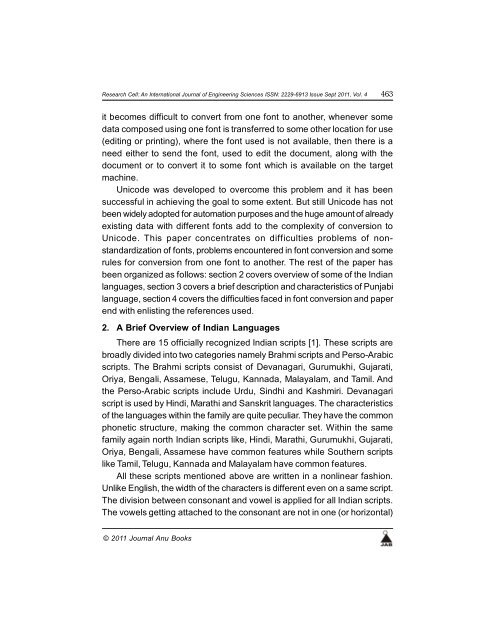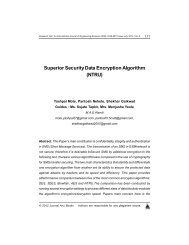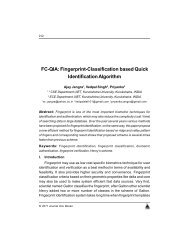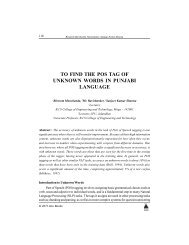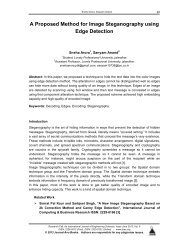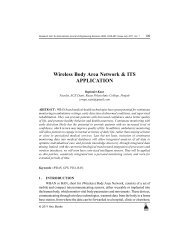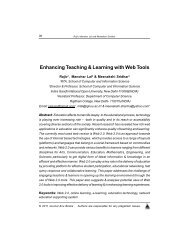An Analysis of Difficulties in Punjabi Language ... - Ijoes.org
An Analysis of Difficulties in Punjabi Language ... - Ijoes.org
An Analysis of Difficulties in Punjabi Language ... - Ijoes.org
You also want an ePaper? Increase the reach of your titles
YUMPU automatically turns print PDFs into web optimized ePapers that Google loves.
Research Cell: <strong>An</strong> International Journal <strong>of</strong> Eng<strong>in</strong>eer<strong>in</strong>g Sciences ISSN: 2229-6913 Issue Sept 2011, Vol. 4<br />
463<br />
it becomes difficult to convert from one font to another, whenever some<br />
data composed us<strong>in</strong>g one font is transferred to some other location for use<br />
(edit<strong>in</strong>g or pr<strong>in</strong>t<strong>in</strong>g), where the font used is not available, then there is a<br />
need either to send the font, used to edit the document, along with the<br />
document or to convert it to some font which is available on the target<br />
mach<strong>in</strong>e.<br />
Unicode was developed to overcome this problem and it has been<br />
successful <strong>in</strong> achiev<strong>in</strong>g the goal to some extent. But still Unicode has not<br />
been widely adopted for automation purposes and the huge amount <strong>of</strong> already<br />
exist<strong>in</strong>g data with different fonts add to the complexity <strong>of</strong> conversion to<br />
Unicode. This paper concentrates on difficulties problems <strong>of</strong> nonstandardization<br />
<strong>of</strong> fonts, problems encountered <strong>in</strong> font conversion and some<br />
rules for conversion from one font to another. The rest <strong>of</strong> the paper has<br />
been <strong>org</strong>anized as follows: section 2 covers overview <strong>of</strong> some <strong>of</strong> the Indian<br />
languages, section 3 covers a brief description and characteristics <strong>of</strong> <strong>Punjabi</strong><br />
language, section 4 covers the difficulties faced <strong>in</strong> font conversion and paper<br />
end with enlist<strong>in</strong>g the references used.<br />
2. A Brief Overview <strong>of</strong> Indian <strong>Language</strong>s<br />
There are 15 <strong>of</strong>ficially recognized Indian scripts [1]. These scripts are<br />
broadly divided <strong>in</strong>to two categories namely Brahmi scripts and Perso-Arabic<br />
scripts. The Brahmi scripts consist <strong>of</strong> Devanagari, Gurumukhi, Gujarati,<br />
Oriya, Bengali, Assamese, Telugu, Kannada, Malayalam, and Tamil. <strong>An</strong>d<br />
the Perso-Arabic scripts <strong>in</strong>clude Urdu, S<strong>in</strong>dhi and Kashmiri. Devanagari<br />
script is used by H<strong>in</strong>di, Marathi and Sanskrit languages. The characteristics<br />
<strong>of</strong> the languages with<strong>in</strong> the family are quite peculiar. They have the common<br />
phonetic structure, mak<strong>in</strong>g the common character set. With<strong>in</strong> the same<br />
family aga<strong>in</strong> north Indian scripts like, H<strong>in</strong>di, Marathi, Gurumukhi, Gujarati,<br />
Oriya, Bengali, Assamese have common features while Southern scripts<br />
like Tamil, Telugu, Kannada and Malayalam have common features.<br />
All these scripts mentioned above are written <strong>in</strong> a nonl<strong>in</strong>ear fashion.<br />
Unlike English, the width <strong>of</strong> the characters is different even on a same script.<br />
The division between consonant and vowel is applied for all Indian scripts.<br />
The vowels gett<strong>in</strong>g attached to the consonant are not <strong>in</strong> one (or horizontal)<br />
© 2011 Journal <strong>An</strong>u Books


